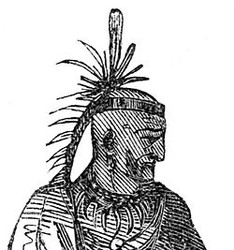Chief Cornstalk Gravesite
Introduction
Text-to-speech Audio
Images
Artist's rendition of Chief Cornstalk

This monument was dedicated in 1954 along with the remains of Chief Cornstalk (three teeth and 15 bone fragments) buried below the monument.

Backstory and Context
Text-to-speech Audio
Cornstalk was born sometime during the 1720s. His native name was Hokolesqua or Keigh-tugh-qua, which roughly translates to “maize plant” or blade of corn.” Therefore he became known to the colonists as Cornstalk. He was a member of the Shawnee tribe, which at the time of his birth lived in Pennsylvania but was later forced to move to Ohio. Eventually he became chief of the Shawnee tribe and was well-respected by both other tribes and the colonists. During the French and Indian War the Shawnees supported the French, and Cornstalk led a series of raids against British settlements in western Virginia; on one occasion he reportedly killed ten settlers in 1759. Soon after the end of the war Cornstalk participated in Pontiac’s Rebellion of 1763. The conflict was bloody but short-lived, and in 1764 Cornstalk and several other tribal members were taken prisoner and held hostage at Fort Pitt in order to enforce a peace treaty with the Shawnees. He escaped a year later according to some reports.
Cornstalk spent the next several years trying to maintain peace with the colonists. Increased settlement of the Ohio Valley caused tensions to rise however, and hostilities began to flare up along the Ohio River. In 1774 Lord Dunmore, the colonial governor of Virginia, assembled two armies to launch an attack on the Shawnee tribe. Cornstalk reluctantly rallied a force of around 1,000 fighters to confront the invasion. In October he crossed the Ohio River and attacked a colonial army of around the same size at Point Pleasant. The Battle of Point Pleasant was fought on October 10. Cornstalk, believing that colonial reinforcements had arrived, ordered a retreat. He signed a peace treaty with Lord Dunmore a few days later, abandoning Shawnee claims to all land east of the Ohio River.
During the American Revolution, the British tried to recruit the Shawnees to fight against the Americans. Some of the Shawnees sided with the British, but Cornstalk was doubtful of victory and sought to keep the peace with the colonists. In 1777 he, his son Elinipsico, and a sub-chief named Red Hawk journeyed to Fort Randolph in Point Pleasant to warn the American forces there that the British were turning tribal forces against them. The soldiers immediately imprisoned Cornstalk and the others, holding them as hostages. On November 10, 1777, Cornstalk and the other prisoners were murdered by the soldiers in retaliation for the deaths of two white men who were apparently killed by Native Americans.
After his death, Cornstalk was buried near Fort Randolph. In 1840, construction workers building a new road in the area discovered his grave, which was moved and reburied on the grounds of the Mason County Courthouse. The courthouse was demolished in 1954 to make way for a larger one. During the process, Cornstalk’s grave was uncovered again to be moved to Tu-Endie-Wei State Park, the site of the Battle of Point Pleasant. By this point only three teeth and fifteen bone fragments remained of his body. They were sealed in an aluminum box and buried underneath a small, four-ton stone obelisk in the park.
Sources
Benington, Dale K. “Chief Cornstalk.” The Historical Marker Database. October 26, 2018. Accessed November 15, 2018. https://www.hmdb.org/marker.asp?marker=20790
“Fighting Chief Cornstalk’s Remains Laid to Rest Again.” Charleston Gazette. September 21, 1954. Accessed November 15, 2018. http://www.wvculture.org/history/notewv/corn1.html
“Hokolesqua.” Ohio History Central. Accessed November 15, 2018. http://www.ohiohistorycentral.org/w/Hokolesqua
Lizza, Richard P. “Cornstalk.” e-WV: The West Virginia Encyclopedia. October 8, 2012. Accessed November 15, 2018. https://www.wvencyclopedia.org/articles/1602
“Lord Dunmore’s War and the Battle of Point Pleasant.” Ohio History Central. Accessed November 15, 2018. http://www.ohiohistorycentral.org/w/Lord_Dunmore%27s_War_and_the_Battle_of_Point_Pleasant
Sturm, Philip. “Battle of Point Pleasant.” e-WV: The West Virginia Encyclopedia. April 22, 2016. Accessed November 15, 2018. https://www.wvencyclopedia.org/articles/1889
